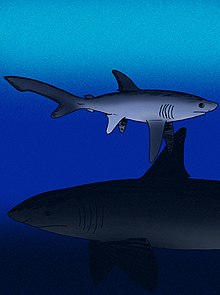Alopias grandis is a species of giant thresher shark from the Miocene. Estimates calculated from teeth comparisons suggest the living animal was comparable in size to the extant great white shark.[3] Remains generally consist of teeth, which have been found in the United States in the Calvert Formation of Virginia and Maryland,[4] and in Beaufort County, South Carolina.[3] They have also been found in the Miocene of Malta.[5] It is unlikely it possessed the elongated tail lobe of modern thresher sharks.[3] Some specimens in the Burdigalian show the beginnings of serrations, which are presumably transitional individuals between A. grandis and A. palatasi.[5]
| Alopias grandis Temporal range: [1]
| |
|---|---|

| |
| Fossilized tooth | |
| Scientific classification | |
| Domain: | Eukaryota |
| Kingdom: | Animalia |
| Phylum: | Chordata |
| Class: | Chondrichthyes |
| Subclass: | Elasmobranchii |
| Subdivision: | Selachimorpha |
| Order: | Lamniformes |
| Family: | Alopiidae |
| Genus: | Alopias |
| Species: | A. grandis
|
| Binomial name | |
| Alopias grandis Leriche, 1942
| |
| Synonyms[2] | |
|
Alopecias grandis | |

References
edit- ^ "†Alopecias grandis Leriche 1942 (mackerel shark)". The Paleobiology Database.
- ^ "Alopecias grandis Leriche 1942 (mackerel shark)". PBDB.
- ^ a b c Ward, D. J.; Kent, B. W. (2015). "A new giant species of thresher shark from the Miocene of the United States". Natural History Museum. doi:10.13140/RG.2.1.1723.0969.
{{cite journal}}: Cite journal requires|journal=(help) - ^ "Nomini Cliffs, Zone 14-16 (Miocene of the United States)". PBDB.
- ^ a b Godfrey, S. J. (Ed.). (2018). The Geology and Vertebrate Paleontology of Calvert Cliffs, Maryland, USA. Smithsonian Institution Scholarly Press.